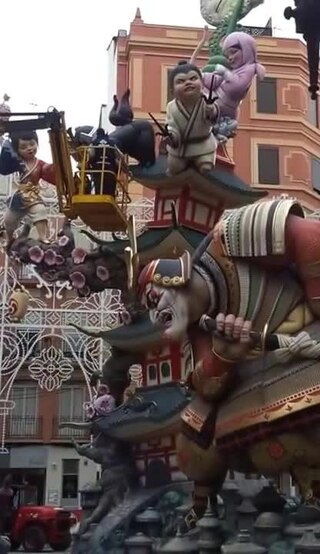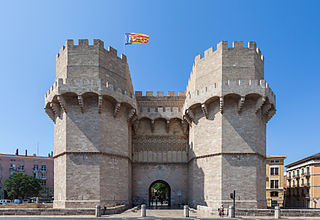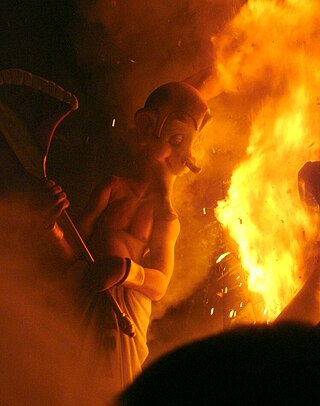Clothing
The faller (man) should wear:
- The costume typically used in Alzira since 1968: black trousers, black socks and black shoes, a short black jacket, a white shirt, a white shirt front and a sash of any color with tassels hanging over the left trouser leg.
- The torrentí costume.
- The saragüell costume.
- A costume consisting of long striped trousers, a silk or linen shirt, a waistcoat, a sash, and black shoes with black socks or espadrilles with embroidered socks.
- The use of ties, flowers or bows is forbidden.
The fallera (woman) should wear:
- The formal Valencian farmer's dress, with the fallera's hair arranged in three chignons; the fallera is expected to dress with utmost decency.
- The 18th century costume, with the fallera's hair arranged in one or three chignons.
- The typical regional dress of the Huerta de Valencia, with the fallera's hair arranged in one chignon.
- It is not permitted to use any item of clothing or adornment that is not traditional or is not a part of the costume. The use of espadrilles is only allowed if they are lined with the same fabric as the costume.
The blusón (a checkered shirt) is not considered traditional Valencian clothing and its use is only permitted during strictly private celebrations of the commissions.
1. The current Fallera Major and Fallera Major Infantil (who must not be older than 14), the annually elected "queen" and "junior queen" of the entire Falles festivity, are the only participants allowed to wear the so-called "Alzira model" costume and the combs with the town's coat of arms or that of the Junta Local Fallera.
2. These provisions are enforced by the General Assembly in collaboration with a minimum of two qualified clothing consultants to make sure that the clothing used satisfies the decency requirements and respects the traditions.
3. The traditional sash with the colours of the Spanish flag is the distinctive attribute of the Falleres Majors and the Falleres Majors Infaltils, both those of the entire Falles festivity and those of each of the commissions. The members of their "courts of honour" wear a sash with the colours of the Valencian flag, with the badge and the name of the respective commission embroidered, on a white background, at the top of the blue band.

The Fallas is a traditional celebration held annually in commemoration of Saint Joseph in the city of Valencia, Spain. The five main days celebrated are from 15 to 19 March, while the Mascletà, a pyrotechnic spectacle of firecracker detonation, takes place every day from 1 to 19 March. The term Fallas refers to both the celebration and the Falla monuments burnt during the celebration. A number of towns in the Valencian Community have similar celebrations inspired by the original Fallas de Valencia celebration. For example, the bonfires of Alicante or the Fiestas de la Magdalena in Castellón de la Plana. The Fallas festival was added to UNESCO's intangible cultural heritage of humanity list on 30 November 2016.

Processional giants are costumed figures in European folklore, particularly present in Belgian, French, Portuguese, Spanish, and English folkloric processions. The main feature of these figures is typically their wooden, papier maché or -more recently- synthetic resin head, whilst bodies are covered in clothing matching the costume's theme.

A folk costume expresses a national identity through clothing or costume, which is usually associated with a specific region or period of time in history. It can also indicate social, marital, or religious status. If the costume is used to represent the culture or identity of a specific ethnic group, it is usually known as ethnic costume. Such costumes often come in two forms: one for everyday occasions, the other for traditional festivals and formal wear. The word "costume" in this context is sometimes considered pejorative due to the multiple senses of the word, and in such cases "clothing", "garments" or "regalia" can be substituted without offense.
The Bonfires of Saint John are a traditional and popular festival celebrated in the city of Alicante, Spain, from 19 to 24 June. The celebration ultimately stems from a tradition of bonfires for Saint John's Eve that can be found in many places, among them the Mediterranean coast of Spain, especially Catalonia and the Valencian Community; in Alicante, it's the official and most important festivity in the city. It was officially declared as a Fiesta of International Tourist Interest in 1983 and a Bien de Interés Cultural in 2014.

Highland dress is the traditional, regional dress of the Highlands and Isles of Scotland. It is often characterised by tartan. Specific designs of shirt, jacket, bodice and headwear may also be worn along with clan badges and other devices indicating family and heritage.

Brutus Buckeye is the athletics mascot of Ohio State University and an anthromorphic buckeye nut. Brutus made his debut in 1965, with periodic updates to design and wardrobe occurring in the years since. As a member of the spirit squad, Brutus Buckeye travels to many events around the university and often makes appearances around Columbus.

Serbian traditional clothing, also called as Serbian national costume or Serbian dress, refers to the traditional clothing worn by Serbs living in Serbia, Croatia, Bosnia and Herzegovina, Montenegro, and the extended Serbian diaspora communities in Austria, Australia, Bulgaria, Canada, France, Germany, Greece, Hungary, North Macedonia, Romania, Russia, Slovenia, United States, etc. Like any traditional dress of a nation or culture, it has been lost to the advent of urbanization, industrialization, and the growing market of international clothing trends. The wide range of regional folk costumes show influence from historical Austrian, Hungarian, German, Italian, and Ottoman Turkish presence. Nonetheless, the costumes are still a pinnacle part of Serbian folk culture. From the 19th century and onwards, Serbs have adopted western-styled clothing. This change has started in larger settlements such as cities and towns, although it was not uncommon to see rural women in traditional working costumes all the way until the end of 1970s. Today, these national costumes are only worn by some elderly in rural areas but are most often worn with connection to special events and celebrations, mostly at ethnic festivals, religious and national holidays, weddings, tourist attractions, and by dancing groups who dance the traditional Serbian kolo, or circle dance.

The Armenian Taraz, also known as Armenian traditional clothing, reflects a rich cultural tradition. Wool and fur were utilized by the Armenians along with the cotton that was grown in the fertile valleys. During the Urartian period, silk imported from China was used by royalty. Later, the Armenians cultivated silkworms and produced their own silk.
This is a list of existing articles related to fashion and clothing. For individual designers, see List of fashion designers
Moncada is a municipality in the comarca of Horta Nord in the Valencian Community, Spain.

Croatian national costume, also called as Croatian traditional clothing or Croatian dress, refers to the traditional clothing worn by Croats living in Croatia, Bosnia and Herzegovina, Serbia, with smaller communities in Hungary, Austria, Montenegro, and Romania. Since today Croats wear Western-style clothing on a daily basis, the national costumes are most often worn with connection to special events and celebrations, mostly at ethnic festivals, religious holidays, weddings, and by dancing groups who dance the traditional Croatian kolo, or circle dance.
Azerbaijani traditional clothing is the traditional attire of the Azerbaijani people. It is closely connected to its history, religious culture and national identity.

Traditional clothing is one of the factors that has differentiated this nation from neighboring countries, dating back as far as the Illyrian era.

Greek dress refers to the clothing of the Greek people and citizens of Greece from the antiquity to the modern times.

The plantá is the act of erecting a Falla or bonfire monument, in the Fallas or the Bonfires of Saint John, festivals held respectively in March and June in different localities of the community of Valencia (Spain).The plantà is currently considered the exact moment when the falla or bonfire is completely finished and ready to be visited, with all its "ninots", posters and a variety of features.

The Serrans Gate or Serranos Gate, also known as Serrans Towers or Serranos Towers is one of the twelve gates that formed part of the ancient city wall, the Christian Wall, of the city of Valencia, Spain. It was built in Valencian Gothic style at the end of the 14th century. Its name is probably due to its location in the northwest of the old city centre, making it the entry point for the royal road connecting Valencia with the comarca or district of Els Serrans as well as the entry point for the royal road to Barcelona, or because the majority of settlers near there in the time of James I of Aragon were from the area around Teruel, whose inhabitants were often called serrans by the Valencians. Alternatively, the gate may also have been named after an important family, the Serrans, who lived in a street with the same name.

A Falla or monumento fallero is an artistic monument, usually large composed of figures called ninots, which typically encircle one or more bigger central figures, called remates. The fallas are placed in the streets during the Falles festival in Valencia (Spain), and in other towns with festivals inspired by it. The monument usually deals with a satirical subject connected with recent news or public controversies, and is covered in posters with words, verses and statements of a humorous nature. The monument is made with combustible materials which are then burned in the streets after being on show for a few days.

The cremà is the act of setting fire to a falla monument, made from materials such as cardboard and wood, during the festivities of several towns in the Valencian community, Spain. A similar celebration is the Bonfires of Saint John from Alicante, also in the Valencian community. In all cases the celebration ends with the burning of the monuments.
The Entrance of the flower is celebrated on 1 February in Torrent, Valencian Community, Spain. The traditional Entrance of the flower is a deep-rooted festivity in the municipality that traces back to the 17th century, in which the clavarios and members of the Confrerie of the Mother of God deliver a branch of the first-blooming almond-tree to the Virgin.














